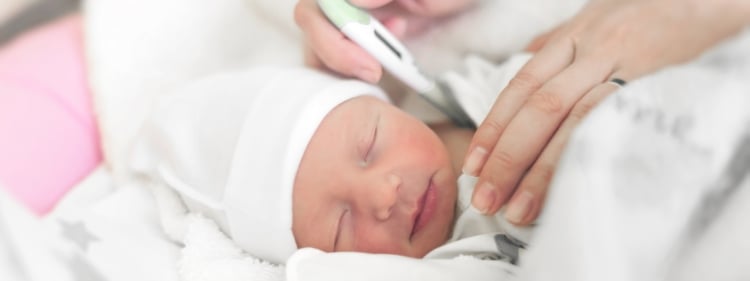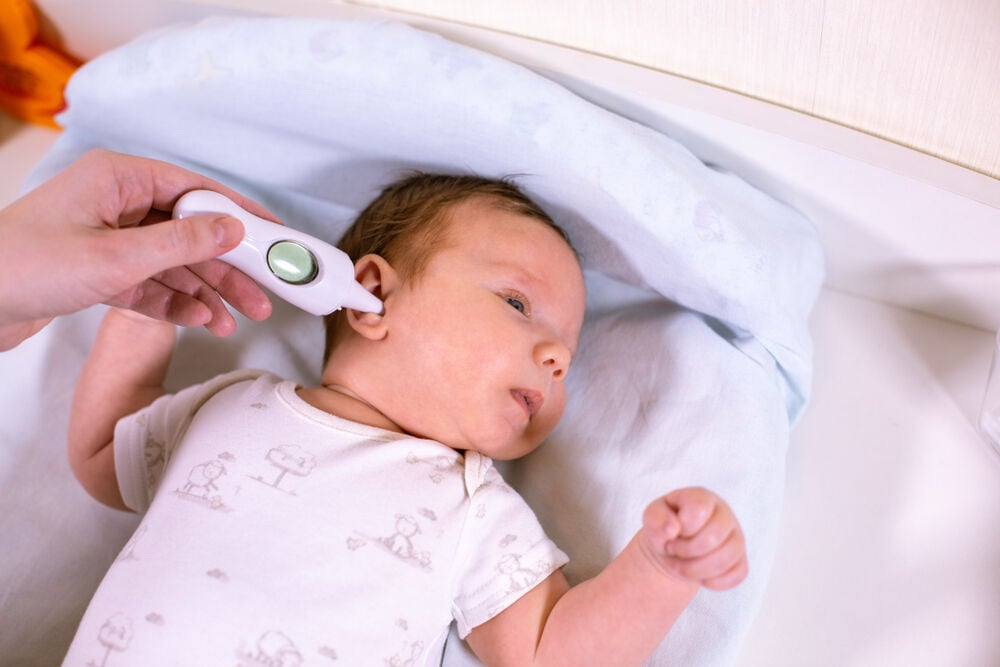When your baby arrives into the world, their temperature can change easily as they adapt to life outside of your womb. Though the normal baby temperature lies between 96.8 degrees Fahrenheit and 100.3 degrees Fahrenheit, there are instances when it can fall outside of this range. Read on to learn more about newborn temperature.
-
Tracking cycle
-
Getting pregnant
-
Pregnancy
-
Help Center
-
Flo for Partners
-
Anonymous Mode
-
Flo app reviews
-
Flo Premium New
-
Secret Chats New
-
Symptom Checker New
-
Your cycle
-
Health 360°
-
Getting pregnant
-
Pregnancy
-
Being a mom
-
LGBTQ+
-
Quizzes
-
Ovulation calculator
-
hCG calculator
-
Pregnancy test calculator
-
Menstrual cycle calculator
-
Period calculator
-
Implantation calculator
-
Pregnancy weeks to months calculator
-
Pregnancy due date calculator
-
IVF and FET due date calculator
-
Due date calculator by ultrasound
-
Medical Affairs
-
Science & Research
-
Pass It On Project New
-
Privacy Portal
-
Press Center
-
Flo Accuracy
-
Careers
-
Contact Us
Newborn’s Temperature and How to Keep It Normal

Every piece of content at Flo Health adheres to the highest editorial standards for language, style, and medical accuracy. To learn what we do to deliver the best health and lifestyle insights to you, check out our content review principles.
Normal newborn’s temperature and how to measure it correctly
The normal temperature for newborn babies usually falls between 96.8 degrees Fahrenheit and 100.3 degrees Fahrenheit, with the average normal baby temperature being 98.6 degrees Fahrenheit. Your baby has a fever if their temperature goes over this range to more than 100.4 degrees Fahrenheit. This is especially true if the reading has been taken using the rectal method.
There are various ways to take a baby’s temperatures. The values might differ, but they are all important in their own way. Here are a few different ways to take a temperature:
- Rectal
- Temporal artery
- Axillary/underarm
- Oral
- Tympanic
Rectal temperature
The normal newborn temperature usually refers to the rectal temperature because it offers a truer reflection of the baby’s basal body temperature. On average, body temperature often hovers around the 98.6 degrees Fahrenheit mark. However, it can fluctuate and move to anywhere in the range of 96.8 to 100.3 degrees Fahrenheit.
Just like the name suggests, the rectal temperature is taken via the baby’s rectum. A special type of thermometer is used so that the reading can be taken. This is a reliable method to measure temperature in babies from birth to four years of age, especially for infants under three months of age.
Temporal artery temperature
The temporal artery temperature is read from the temple of the baby (the forehead) by the infrared scanner. This temperature is quite similar to the rectal temperature. Therefore, when the temporal artery temperature exceeds the 100.3 degrees Fahrenheit mark, it’s regarded as a fever in the baby. This is a reliable method to measure temperature in children of any age.
Axillary (underarm) temperature
The thermometer for reading this kind of temperature is inserted into the baby’s armpit. Since the underarm area isn’t in an internal body cavity like the rectum, it doesn’t retain heat easily. For this reason, the axillary temperature tends to be lower than the rectal one.
The normal range for this method is 97 to 99 degrees Fahrenheit, with the average normal temperature for babies being 97.6 degrees Fahrenheit. If you measure a temperature this way, a temperature exceeding 99 degrees Fahrenheit is considered a fever.
Oral temperature
As indicated by the name, this temperature is read from a pacifier thermometer in the baby’s mouth. This method also tends to yield a normal value range lower than the rectal temperature. The maximum value temperature is 100 degrees Fahrenheit. If the temperature exceeds this, your baby likely has a fever.
This method offers reliable readings in toddlers older than four years.
Tympanic temperature

A tympanic temperature reading is taken from the ear canal of the baby. The reading is sometimes comparable to what you would get with a rectal reading. However, it’s not advisable to use this reading when your little one hasn’t yet reached half a year in the outside world.
A reading of more than 100.3 degrees Fahrenheit is considered to be feverish. If you suspect a fever, confirm the baby’s temperature by doing a rectal reading.
Take a quiz
Find out what you can do with our Health Assistant
What’s the normal room temperature?
Finding the right room temperature for your baby can be a hard balancing act. You need to ensure that the room isn’t too hot or too cold.
When it’s too cold, the chilly temperature is likely to make your baby fussy and prevent them from having a restful sleep. On the other hand, if the ambient temperature in the room is too hot for the baby, there’s the risk of sudden infant death syndrome.
The ideal room temperature should fall between 72 and 75 degrees Fahrenheit. Babies born prematurely appreciate the higher end of this range — lower temperatures require them to burn more calories to generate their own heat.
Dressing a baby for the weather
When you’re dressing your baby for the weather, use layers of clothing. This makes it easier to adjust how much heat you’re giving them by removing or adding layers of clothes as necessary.
If it’s a cold day, add some extra layers of clothing. If it gets warmer, peel off a few layers. A hat is also a necessary baby wardrobe addition. Not only does it protect from cold breezes, but it also provides protection from direct and hot sunshine.
How to dress a baby for bedtime

When it comes to bedtime, consider dressing your baby in two layers of clothing. For example, use a jumpsuit/onesie and a sleep sack or swaddle blanket. On a normal night, this should be enough.
When it’s warmer than usual, choose lighter weight clothing so that the baby doesn’t get uncomfortably warm. If it’s cold, you can add another layer of clothing, such as a second loose sleeper under the sleep sack to provide adequate warmth.
As a bonus, the swaddling can also help you take a more comfortable breastfeeding position. When satiated, your baby will sleep longer and more comfortably.
It’s advisable to make sure that the sleep sack or swaddle blanket isn’t too large, as the baby can become tangled up in it. The swaddling shouldn’t be too tight, either, as this can impair your little one’s hip development.
How to check if a baby is too hot or too cold
You can check your baby’s temperature by feeling the nape of their neck with your hand. If they’re feeling too hot, the back of the neck will be sweaty. You might also notice flushed cheeks or fussiness.
On the other hand, when the baby is cold, the nape of the neck is cold to the touch. The hands and feet will also feel cold, and they’ll be less active than usual. Adding another layer of clothing and breastfeeding will calm them and warm them up.
In general, the newborn temperature range is between 96.8 and 100.3 degrees Fahrenheit, with the average normal baby temperature being 98.6 degrees Fahrenheit. Although the temperature can be measured from different parts of the body, the rectal temperature provides the clearest, most reliable figure. Be aware of the room temperature so that you can dress your little one accordingly to keep them comfortable.


Hey, I'm Anique
I started using Flo app to track my period and ovulation because we wanted to have a baby.


The Flo app helped me learn about my body and spot ovulation signs during our conception journey.


I vividly
remember the day
that we switched
Flo into
Pregnancy Mode — it was
such a special
moment.
Real stories, real results
Learn how the Flo app became an amazing cheerleader for us on our conception journey.




